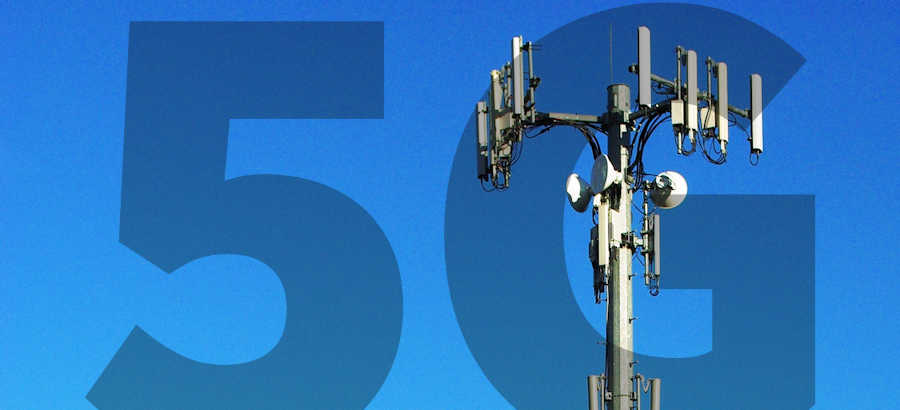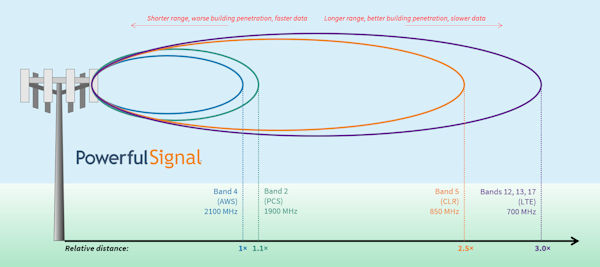What Is 5G?
Are Cell Phone Boosters 5G‑ready?
Powerful Signal answers your questions about the next generation of cellular technologies

Updated
What is a 5G network?
5G is the fifth generation of cellular communications technologies. It includes upgrades to cellular network software, the installation of new antennas and other hardware, and the introduction of new cellular frequencies. 5G dramatically improves the speed of cellular data and increases the number of cellular devices that can connect to a single cell.
5G networks will continue to use current low-band 4G LTE cellular frequencies (600–2700 MHz). Lower-band frequencies travel longer distances and will continue to be used for widespread coverage across North America, especially in rural and outlying suburban areas. 5G improvements will increase the data speeds on these low-band networks by 20 to 40 percent above what 4G could provide.
 Current low-band cellular frequencies can travel long distances, with the lowest frequencies having the longest ranges. The maximum distances of newer 5G frequencies will have shorter ranges than all of these. (Click to enlarge.)
Current low-band cellular frequencies can travel long distances, with the lowest frequencies having the longest ranges. The maximum distances of newer 5G frequencies will have shorter ranges than all of these. (Click to enlarge.)
Cellular carriers are also expanding coverage and increasing data speeds by adding mid-band or “sub-6” frequencies (2700–6000 MHz) and high-band or “millimeter wave” (mmWave) frequencies (24–48 GHz). These higher frequencies provide much faster data rates—as much as 80 times the speed of 4G networks—but higher frequencies don’t travel as far and don’t penetrate building walls, glass, and car roofs as easily. These limitations mean that mid-band and high-band 5G are going to be concentrated in urban and dense suburban locations, where people live, work, and travel very close to cellular antennas.
5G phones have antennas and software that can receive and transmit on low-band, mid-band, and high-band 5G networks. If you don’t plan on getting a 5G-capable phone anytime soon, you’ll still be able to use existing 4G networks.
4G frequencies will continue to be used, they’ll just get faster with 5G technologies. Gaps in 4G and 5G coverage will continue to exist, so some homes and businesses will still need the improved coverage cell signal boosters provide.
Do cell phone boosters work with 5G networks?
Today’s 4G boosters work on most low-band 5G networks. The 4G booster you have now—or the one you’re considering buying—will continue to work indefinitely on existing LTE frequencies.
Before you purchase a cellular booster for your home or business, make sure that your carrier is using bands of frequency in your area that the booster can receive and amplify.
Today’s boosters operate on these 5G cellular bands (and their 4G equivalents):
- Bands n12 and n17 (700 MHz), used by AT&T, T-Mobile, and UScellular
- Band n13 (700 MHz), used by Verizon
- Band n5 (800 MHz), used by Verizon, AT&T, and UScellular
- Band n4 (1700 & 2100 MHz), used by Verizon, AT&T, T-Mobile, and UScellular
- Bands n2 & n25 (1900 MHz), used by Verizon, AT&T, T-Mobile, and UScellular
The FCC has not yet issued blanket approval for cellular boosters to operate on some 4G/5G cellular bands, including:
- Band n71 (600 MHz), used by T-Mobile (learn more)
- Band n26 (800 MHz), used by Dish
- Band n30 (2300 MHz), used by AT&T
- Band n40 (2300 MHz), used by Verizon
- Band n41 (2500 MHz), used by T-Mobile
- All “sub-6” bands (including n46, n48, and n77)
- All mmWave bands (including n258, n260, and n261)
(Click here to see a complete list of cellular frequencies.)
While the FCC hasn’t yet issued blanket approval for some frequencies, booster solutions are beginning to become available and may be operated with explicit permission from your carrier.
Is 5G harmful to people?

The U.S. Centers for Disease Control and Prevention,1 the U.S. Food & Drug Administration,2 the World Health Organization,3 the American Cancer Society,4 and other public agencies and organizations have been studying the effects of cellular phone use since the mid-1990s. While research is still ongoing, the WHO has stated:
A large number of studies have been performed [since the 1990s] to assess whether mobile phones pose a potential health risk. To date, no adverse health effects have been established as being caused by mobile phone use.3
More recently, a systematic review analyzed 63 studies published between 1994 and 2022 and found no association between mobile phone use and head cancers.5
Cellular phones are radio-frequency transmitters. The low-energy electromagnetic frequencies they use—600 MHz to 49 GHz—are non-ionizing. Unlike x-rays and gamma rays, non-ionizing radiation lacks the energy to strip electrons from atoms and cause cellular damage that leads to cancers and other health problems. Electromagnetic radiation starts to ionize at around 3 million GHz6 (3×1016 Hz), nowhere close to 5G frequencies.
 Mobile phones emit non-ionizing radiation at frequencies and wattage lower than visible light.7 (Click to enlarge.)
Mobile phones emit non-ionizing radiation at frequencies and wattage lower than visible light.7 (Click to enlarge.)
Additionally, the transmit power of a cell phone or cell signal booster is typically less than 1 watt. That’s extremely low compared to the power transmitted by an incandescent light bulb (40–75 watts) or used by an LCD television (150 watts) or a vacuum cleaner (1000 watts). The frequency of visible sunlight is between 430,000 and 750,000 GHz,8 and it hits the earth’s upper atmosphere at an average of 340 watts per square meter.9 Cellular devices, by comparison, are some of the lowest-powered devices in your environment.
Non-ionizing radiation can’t damage human tissue at the molecular level like ionizing radiation can, but it can heat it. The transmit power of cell phones and cell boosters is so low, however, that the amount of heat they generate is barely perceptible. A microwave oven cooks food at around 2450 MHz with 1100 watts of power;10 cell phones and WiFi routers operate near that same frequency but with less than 1⁄1000th the transmit power of a microwave oven.
Misguided theories spread on social media that 5G networks were the cause of the – COVID-19 coronavirus epidemic are false and completely lacking in any scientific basis.11
Sources
1 “Frequently Asked Questions about Cell Phones and Your Health,” Centers for Disease Control and Prevention, updated ; The Electromagnetic Spectrum: Non-Ionizing Radiation
,” updated .
2 “Do Cell Phones Pose a Health Hazard?,” U.S. Food & Drug Administration, updated ; “Scientific Evidence for Cell Phone Safety
,” updated
3 “Electromagnetic fields and public health: mobile phones,” World Health Organization, .
4 “Cellular (Cell) Phones,” American Cancer Society, updated . Although the American Cancer Society “does not have any official position or statement on whether or not radiofrequency (RF) radiation from cell phones, cell phone towers, or other sources is a cause of cancer,” their web page describes the numerous studies that have been done on this subject without resulting in any conclusive evidence that cell phones or towers are harmful to humans. The ACS does wisely point out that all studies have limitations.
5 “WHO review finds no link between mobile phone use and brain cancer,” ARPANSA, updated .
6 Emily Laurence, “Is 5G Making You Sick? Here’s What Experts Say,” Forbes Health, updated .
7 Image source: Telecommunications: Exposure and Testing Requirements for Mobile Phones Should Be Reassessed, United States Government Accountability Office, , p. 5.
8 William Harris and Craig Freudenrich, “How Light Works,” HowStuffWorks, accessed .
9 Yuan Gao, answer to “How much energy from the Sun reaches the ground per square meter per minute (solar constant)?”, Quora, .
10 You’re protected from the heating effects of your microwave oven by a Faraday cage that’s built into the oven’s housing. The metal grid embedded in the glass of the oven door is a visible part of that Faraday cage. To learn more, see Jonathan O’Callaghan, “What is a Faraday cage?,” Live Science, .
11 Reuters Staff, “False claim: 5G networks are making people sick, not Coronavirus,” Reuters, .

